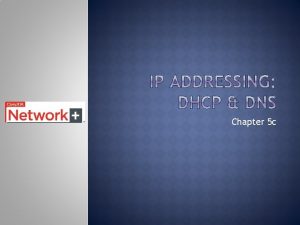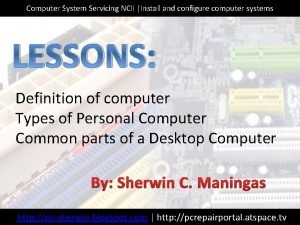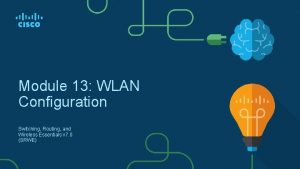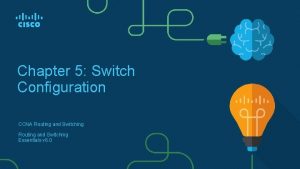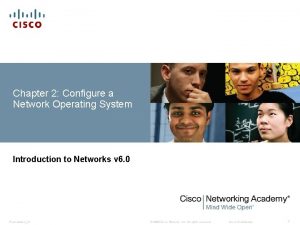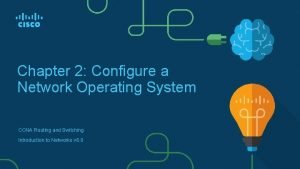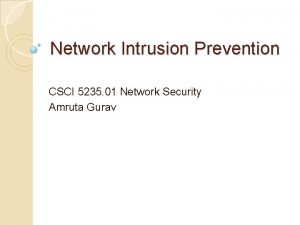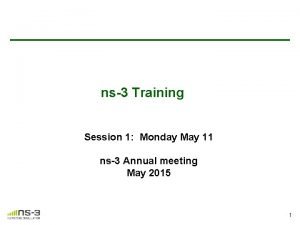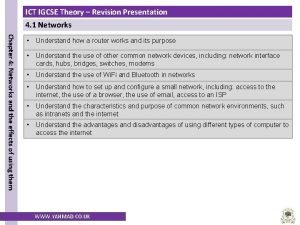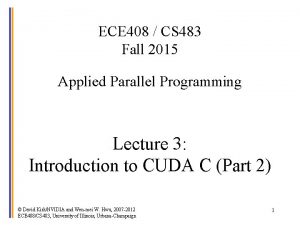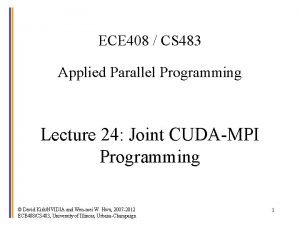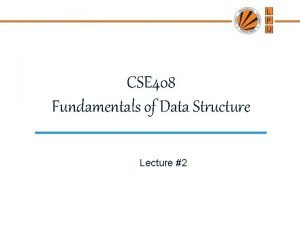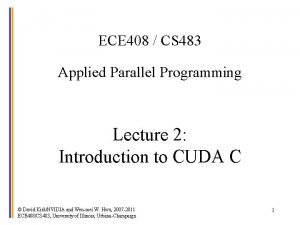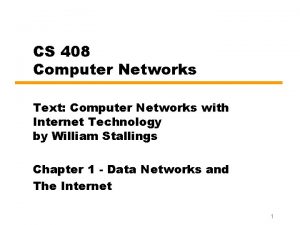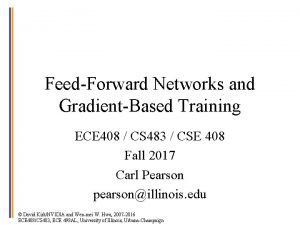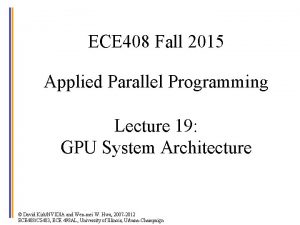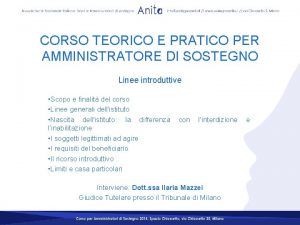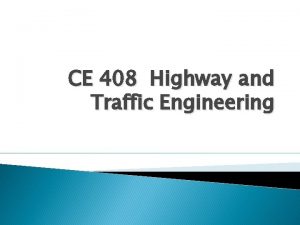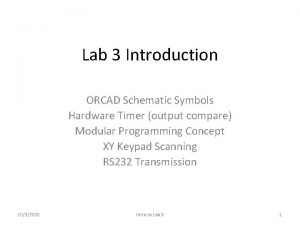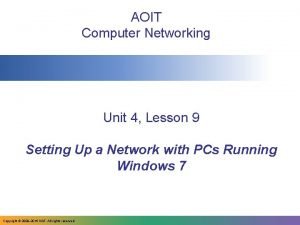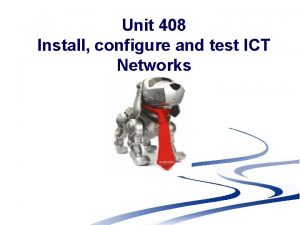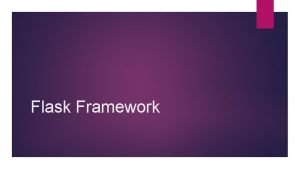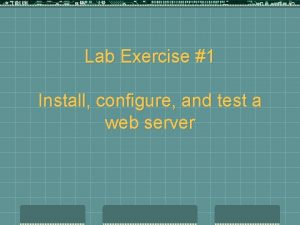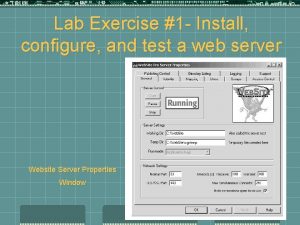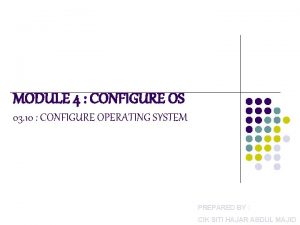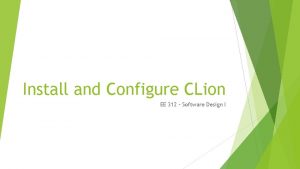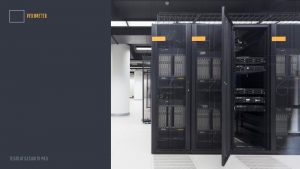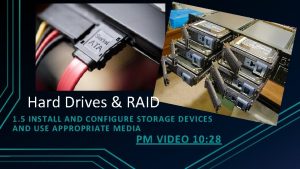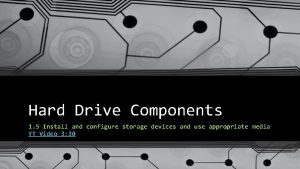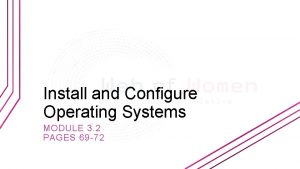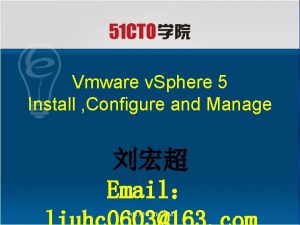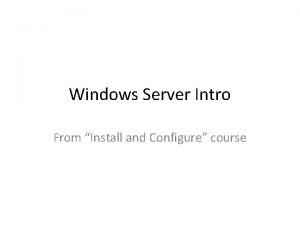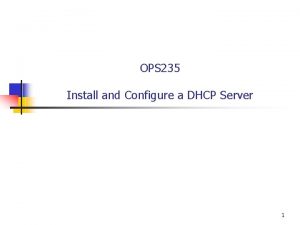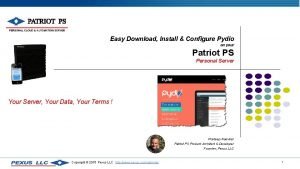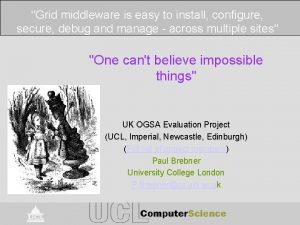Unit 408 Install configure and test ICT Networks



































- Slides: 35

Unit 408 Install, configure and test ICT Networks

Ainsley Smith Tel: 0161 953 5995 Ex 3374 http: //asmithatmancat. wordpress. com/ Ainsley_smith@mancat. ac. uk

Outcome 1 Identify network concepts and terminology Today's session n Summary of last week n Finish off Outcome 1

Last week What are Four basic types ? n LAN n n Wide Are Network SOHO n n Local Area Network Small Office / Home Office NET n Internet work

Last week n What four things does A network typically include? Protocol n Nic – Network interface card n Media n Network Device n

Last week What are the four network topologies? n Bus n Star n Ring n Mesh

Last week Mesh

Last week What is Network Operating System? n A network operating system (NOS) is a piece of software that controls a network and its message traffic and queues

Last week Define User Level Security n Access control to a file, printer or other network resource based on username. Define Share-level security n Access control to a file, printer or other network resource based on knowing the password of that resource.

This week Peer to Peer Networks n Client / Server Networks n Network Security n

Peer to Peer networks n In a peer-to-peer network there are no dedicated servers or hierarchy among the computers. n All of the computers on the network handle security and administration for themselves. n The users must make the decisions about who gets access to what. n All of the computers must have network cards.

Peer to Peer networks n Simple Peer to peer n Cross over cable

n Two Pairs Crossed - Two Pairs Uncrossed 10 base. T/100 base. TX crossover ( shown as T 568 A )

Peer to Peer networks No Crossover Cable

Peer to Peer networks Modern Peer-to-peer are useful for many purposes. n Sharing content files containing audio, video, data or anything in digital format is very common n Napster n Bit torrent etc n

Client/Server Based Networks n While peer-to-peer network is often a good choice for small networks, in an environment with more than 10 -15 computers, a peer-to-peer network begins to become more trouble than it is worth: n computers start to slow down and security is non-existent.

Client/Server Based Networks n n What is the alternative ? A Server n n n A server is simply a computer that is running software that enables it to serve specific requests from other computers, called "clients. " For example, you can set up a file server that becomes a central storage place for your network, A print server that takes in print jobs and ships them off to a printer,

Client/Server Based Networks Server Hardware Basics n Any normal desktop computer could act as a server, but typically you want something much more robust. Standard server hardware includes: n n n Hot-swappable drives (drives that can be replaced while the computer is running) to speed adding or replacing hard disks The ability to support multiple processors Support for larger amounts of RAM Fast network cards Redundant components, such as hard drives and power supplies, to cut down on the chance of the computer failing

Client/Server Based Networks n Server Software n Network Operating system ? n Windows n NT, 2000/2003, Unix Netware etc Will include some type of applications Mail n Web (Internet Information services IIS) n SQL Database n Security (Internet Security and Acceleration ISA) n

Client/Server Based Networks n What about the Clients ? Usually a device (PC, PDA, )connected via network media n Connects via a Lan or WAN n Clients are authenticated onto the network via the network server n Clients can then share network resources n

Client/Server Based Networks

Client/Server Based Networks Security n Businesses need to provide employees, partners, and customers with secure remote access to applications, documents, and data from any PC or device at any location. n SSL n n Secure application publishing and secure socket layer Secure Sockets Layer (SSL), are cryptographic protocols that provide secure communications on the Internet for such things as web browsing, e-mail, Internet faxing, instant messaging and other data transfers

Network Security The firewall ? n A Firewall is a hardware or software device which is configured to permit or deny, data through a computer network.

Network Security A firewall's basic task is to regulate the flow of traffic between computer networks of different trust levels. n Typical examples are the Internet which is a zone with no trust and an internal network which is a zone of higher trust. n A firewall's function within a network is similar to a fire door in building n


Network Security n VPN n n n virtual private network A virtual private network (VPN) is a communications network tunnelled through another network, and dedicated for a specific network. One common application is secure communications through the public Internet n Enable organizations to make their servers accessible to remote users over a fully protected application-layer connection. n RSA secure ID token n Pre-authenticating users before they gain access to any servers

Internet Security and Acceleration ISA Server 2006 is an integrated security gateway that helps protect IT environments from Internet-based threats n Provides users fast and secure remote access to applications and data.

Internet Security and Acceleration ISA

Internet Access Technology (broadband) DSL? n Digital subscriber line n n A family of technologies that provide digital data transmission over the wires of a local telephone network. Typically, the download speed of consumer DSL services ranges from 256 kilobits per second (kbit/s) to 24, 000 kbit/s, ADSL? n Asymmetric Digital Subscriber Line n Upload speed is lower than download speed SDSL? n Symmetric Digital Subscriber n Has same download speed and up load speed

Internet Access Technology (dial up) PSTN n The public switched telephone network n n n A network of the world's public circuit-switched telephone networks, in much the same way that the Internet is the network of the world's public IP-based packet-switched networks. Originally a network of fixed-line analogue telephone systems, the PSTN is now almost entirely digital, and now includes mobile as well as fixed telephones. It is sometimes referred to as the Plain Old Telephone Service (POTS).

Internet Access Technology (Satellite) n If you or your business are located in an area where there’s no ADSL or cable, the best alternative is satellite broadband. n Early satellite broadband offerings were often slow and were hampered by high latency. n The technology has moved on since these early attempts and it’s now possible to get small business systems that closely emulate ADSL, along with more dynamic low latency systems that support advanced broadband applications like VPN, Voice-Over IP and Video Conferencing.

Internet Access Technology (Satellite) n Managed solutions are available that can give up to 2048 kbps download and 1024 kbps upload. n Satellite broadband hardware costs start at around £ 1, 300 installed, and monthly service costs start at £ 59. 99 for a basic 1 user system. Coverage is available anywhere in the UK including the Channel Isles and the Scottish Islands. Typical lead times are 10 days from order.

Internet Access Technology (wireless) Low-cost and easily-installed Wi-Fi grew rapidly in popularity in the early 2000 s. n These devices offered a way to avoid the tangled messes of category 5 cable associated with typical Ethernet networks n Wireless networking lags behind wired networking in terms of increasing bandwidth and throughput. n

Internet Access Technology (wireless) A typical wireless devices for the consumer market can reach speeds of 11 Mbit/s (megabits per second) 802. 11 g. n As of 2006 a new standard for wireless, 802. 11 n is awaiting final certification from IEEE. n This new standard operates at speeds up to 540 Mbit/s and at longer distances than 802. 11 g. n

End of Outcome 1 Unit 408 Next week Outcome 2 Identify components that make up a network
 Lab 3-5: install and configure dhcp and dns servers
Lab 3-5: install and configure dhcp and dns servers In css nc ii, avr stands for
In css nc ii, avr stands for Comparison of virtual circuit and datagram networks
Comparison of virtual circuit and datagram networks Unit 6 review questions
Unit 6 review questions Wlan configuration packet tracer
Wlan configuration packet tracer Troubleshooting a vlan implementation scenario 1
Troubleshooting a vlan implementation scenario 1 Configure gateway cisco switch
Configure gateway cisco switch Surface hub local admin account
Surface hub local admin account Configure a network operating system
Configure a network operating system Victron ethernet remote
Victron ethernet remote Configure to order example
Configure to order example Configuring a network operating system
Configuring a network operating system Configure ios intrusion prevention system (ips) using cli
Configure ios intrusion prevention system (ips) using cli Ns3 training
Ns3 training Algebra 2 unit 1 test answers
Algebra 2 unit 1 test answers Igcse ict chapter 4
Igcse ict chapter 4 Basestore iptv
Basestore iptv Cs483 uiuc
Cs483 uiuc Cs 483
Cs 483 Cse 408
Cse 408 408b2
408b2 Usace section 408
Usace section 408 Nyc doe chapter 408 forms
Nyc doe chapter 408 forms Ece 408
Ece 408 Cs 408 sabancı
Cs 408 sabancı Pub 408
Pub 408 Ece 408
Ece 408 Ece408
Ece408 Art 408 cc
Art 408 cc Ce 408
Ce 408 Hyp opp adj triangle
Hyp opp adj triangle Cambridge technicals ict level 3 unit 1 resources
Cambridge technicals ict level 3 unit 1 resources What are ways to install and maintain equipment
What are ways to install and maintain equipment Lab 3-9 select and install memory
Lab 3-9 select and install memory Unit 5 managing networks
Unit 5 managing networks Unit 4 computer networks
Unit 4 computer networks
